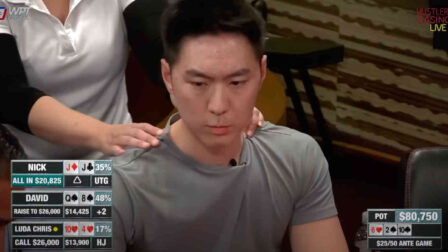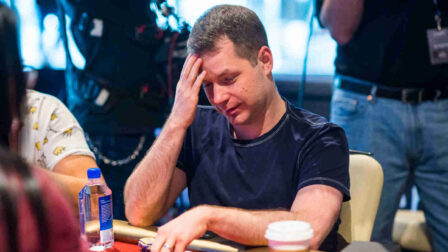FLOATING IN POKER: Put Your Opponents To The Test

11 minutes
Last Updated: March 19, 2024
While many new players misuse this move, it has an important part in Texas Holdem and can be quite a powerful weapon when used correctly.
Floating can significantly improve your strategy and give additional options to play the hand.
In this article, we’ll cover different aspects of floating in poker and discuss strategies for both in and out of position play in 3bet and single raised pots.
Table of content
- What is floating
- General rules
- In position play
- Out of position play
- 3bet pots
- Exploitative adjustments
- Conclusion
What is Floating In Poker?
To start with, let’s first define the term.
Floating is the type of play where you call your opponent’s bet on the flop with a very weak hand with the plan to bluff on the later streets.
The term can feel a bit unclear as some players tend to over-use it.
For a play to qualify as a float, you need to have a very weak poker hand that doesn’t have much of a chance to win at a showdown in its current state, and you don’t have a strong draw, either.
For example, if you check-call with a flush draw, that’s not floating. You’re simply paying to try and realize your equity, so that is an entirely different play.
The floating strategy is most often used against someone who tends to continuation bet the flop too much and then usually gives up.
Against these players, you can float quite comfortably as you’ll often have plenty of opportunities to win the pot on later streets even if unimproved.
General Requirements for a Successful Float
Like with many things in poker, players often tend to justify over-calling in various situations as “floating”. However, for the float to be successful:
- You need to be in a heads up pot – you shouldn’t float against multiple opponents because the odds of someone having a strong made hand already go up significantly.
- Your hand needs to have some sort of backdoor equity – unless you are up against an opponent that c-bets far too much, you need to have a hand that will improve to a winner by a showdown at least some percentage of the time. (for example runner runner draw or a gutshot)
- You need to have enough chips – floating only works if stacks are deep enough, and you have some room to make a move. If SPR (stack to pot ratio) is such that you almost have no fold equity after you call the flop bet, the float doesn’t make much sense, and it won’t work very often.
Floating Strategy Against C-bet in Position
Like many other things, floating when you have a position on the opponent driving the action tends to be much easier.
When you have the last say in the hand, you can have a much wider floating range as you’ll have much more information about the strength of the opponent’s hand.
This doesn’t mean you should go crazy and call the flop with any two cards, but it should play a significant role in your decision-making process.
The main idea behind structuring the floating range in position is picking hands that can easily improve to a good draw on the turn. When this happens and the opponent checks on the turn, you can take a stab at the pot and often win it right then and there.
Even when you get called, you still have decent equity going to the river. You can hit your draw or improve to a top pair with over-cards, which will often be enough to win at a showdown.
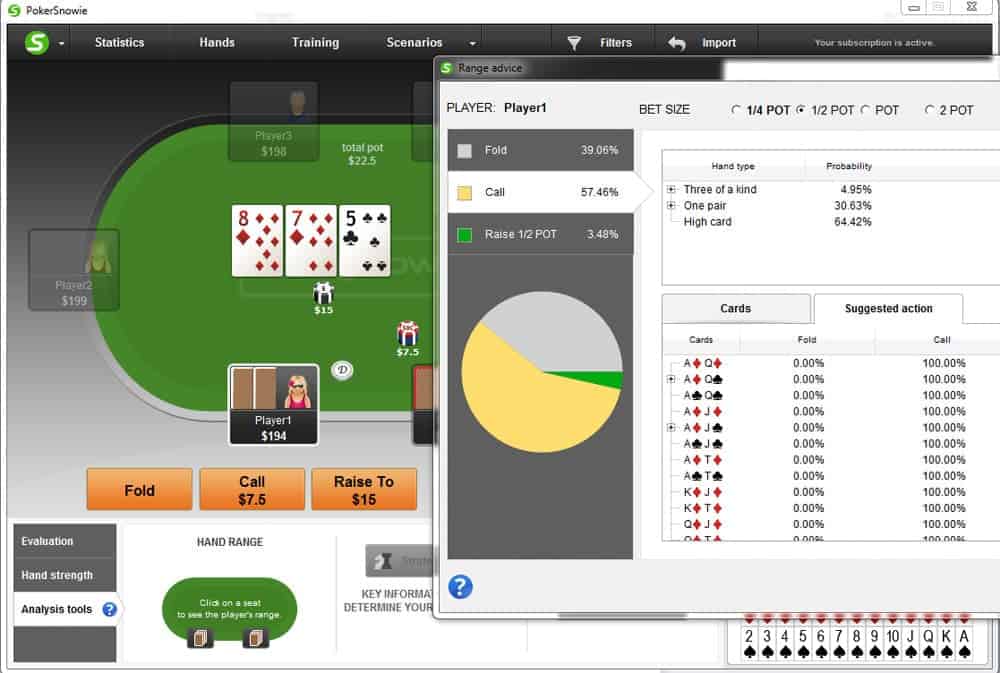
Get PokerSnowie FREE Trial and try it yourself!
In this spot, Poker Snowie suggests floating with many holdings that contain over-cards and backdoor flush draws. Hands such as AcTc, for example, are very good candidates, because you can easily barrel away on most clubs on the turn and take over the betting lead.
As a general rule of thumb, the better the flop for your range is, the more hands you should be floating and then bluffing later. If you get a flop that is very good for your preflop calling range, you might be floating the flop with a big part of your holdings.
It is worth noting that a slight downside of using Snowie here is the fact you can’t define your button calling range manually, so the software doesn’t have as many hands as you might expect to see, and we can’t effectively analyze different runouts. After all, it all starts with the right preflop strategy.
With that in mind, it is essential to understand the main reasoning behind the play, and you’ll be good to go. How you structure your preflop calling ranges may depend on the type of opponent you’re up against, but once you get to the flop, you need to think about what constitutes a good candidate for a float.
You want to pick hands that can turn into good draws on the turn or leap ahead by hitting a top pair. These hands give you multiple opportunities to win the pot by either bluffing or getting there and showing down the best hand.
Holdings that have the potential to make the nuts (or close to it) by the river, even if their equity isn’t all that great on the flop, are usually the best candidates for floating in poker.
However, you should not eliminate bluffing even without improving your hand if your opponents decide to check on the turn because that is the big part of we you float in the first place.
Of course, you need to choose good boards and runouts for your range, but when you are in position, you can easily put a lot of pressure on your opponents.
Floating Strategy Against C-bet Out of Position
One of the most common floating spots out of position is when you are in the big blind and defend against an original raiser. So we will analyze this situation and assume that you check to the raiser, and then call his c-bet with a plan to bluff later.
It is worth mentioning that it is harder to float when you are OOP, yet that is still a move you must implement in your play.
Your floating range should vary depending on the opponent. Of course, against players who c-bet too often, you can float with a bit wider range or even implement an aggressive check-raising strategy. However, even against better opponents, you should have a floating range.
The best way to bring this point home is through some examples.
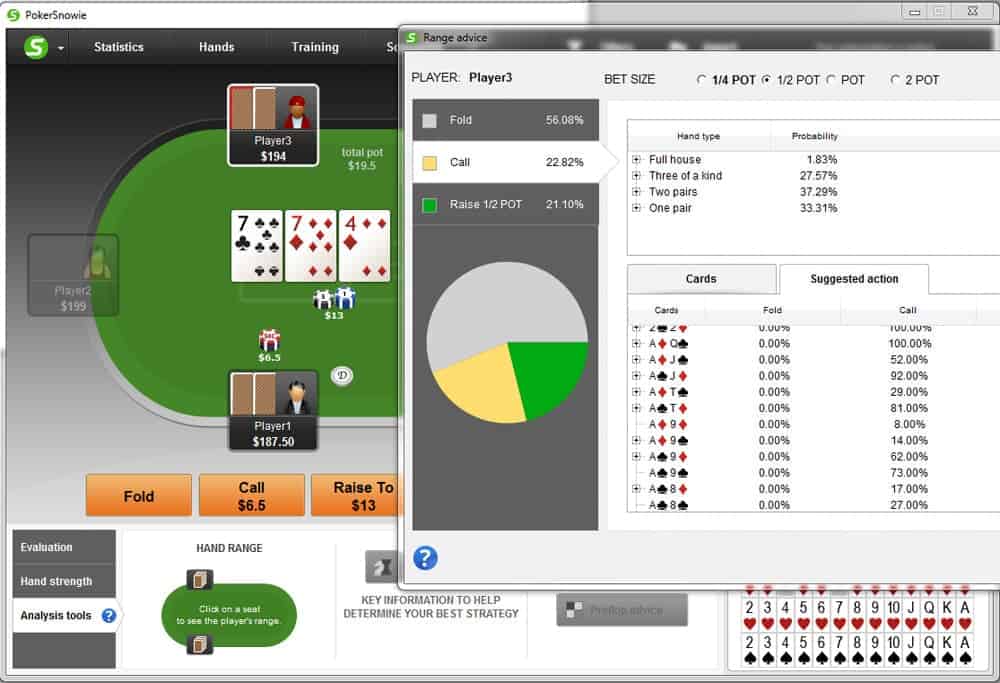
The spot in the picture is a fairly standard one. The button opens, you defend from the big blind and check on the flop of 7c 7d 4d, where the original raiser fires a continuation bet of half the pot.
As you can see, Poker Snowie suggests calling with close to 23% of your entire preflop range, and a part of that range can be clearly defined as floats.
Your floating range contains hands with Ac and other smaller clubs that can help make a straight (6, 8, 9), as well as hands with Ad, or even over-cards.
All of these aren’t too likely to be the best hand by the showdown, but they have the potential to improve by the river, or can be used to bluff. So if you call and the turn goes check-check, you are in a spot to pick many pots even if unimproved.
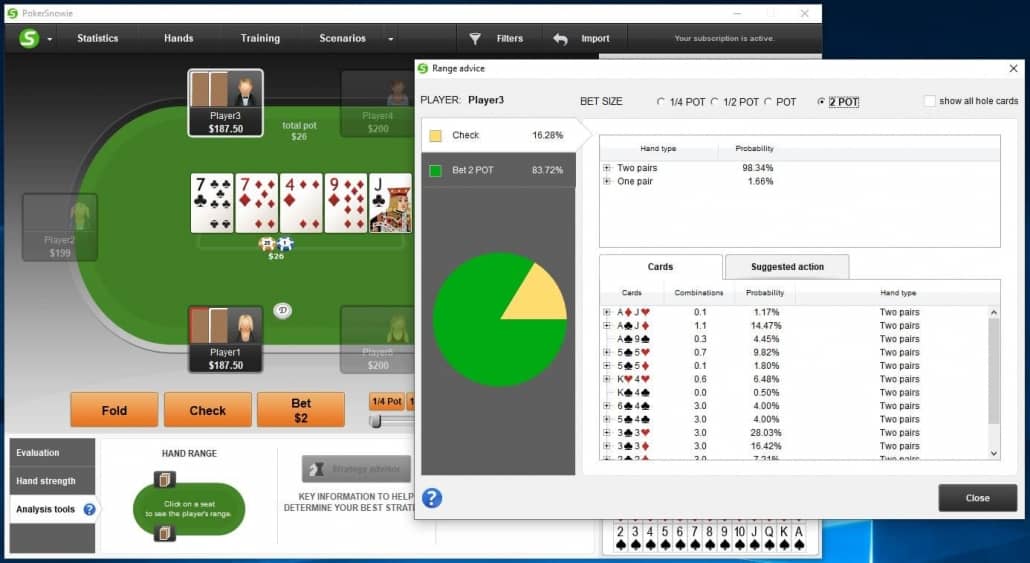
In this spot, Snowie suggests over-betting with about 84% of the hands. Of course, there are many value hands in that range, but there are also some floats that didn’t get there.
Since the board has run out quite favorably for your perceived range, you can expect to win a decent percentage of the time without having to go to the showdown, and bluff with your floats that have blockers.
Having these floats in our defending range helps balance our overall big blind strategy. It makes things more difficult for your opponents as they have to deal with different lines, and makes you a tougher player.
Floating in 3-bet Pots
When it comes to 3-bet pots, you have to be very careful. In these spots, you have to pay special attention to your stack depth and SPR as floating only works when you are deep enough and have some room to make your move later on.
In Position
When playing against a 3-bet in position, your floating range doesn’t change all that much in comparison to calling a c-bet in a single raised pot. Of course, this is assuming we’re playing at least 100 big blinds deep so that our SPR allows us to float.
It is a fairly common scenario in the button vs. big blind battles, where we raise from the button, face a 3-bet from the blind, and decide to call. Depending on the board texture and the size of the continuation bet, we can pick a range of hands to float. Here’s what Poker Snowie has to say on the topic.
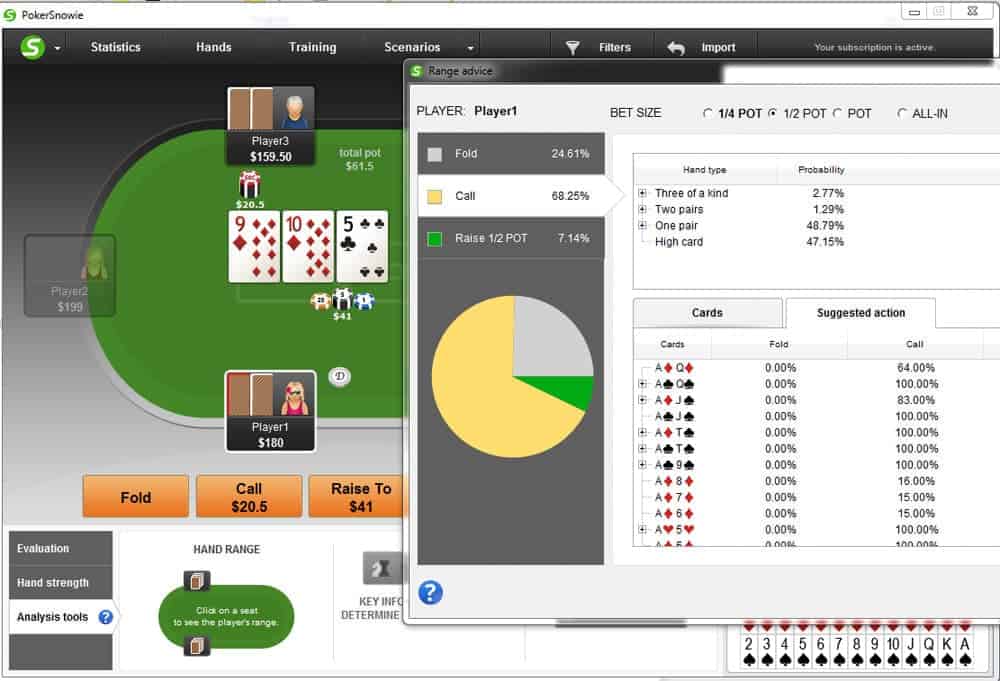
Get PokerSnowie FREE Trial and try it yourself!
You can see that Snowie advocates floating with hands such as AdJc and AcQc. Both of these hands are great candidates on this particular board texture because there are many cards we can pick on the turn that will provide us with bluffing opportunities if the opponent checks on the turn.
Diamonds, clubs, Jacks, Queens – all of these can be favorable cards on which we can take control of the hand and win the pot without even having to go to the showdown.
Of course, it is worth mentioning that you should not be floating much on dry boards, because your opponent will have range advantage, and you will not be able to pull many tricks. However, when you have a position and see the board that hits your range, feel free to float even in a 3bet pot.
Out of Position
Floating in poker is a powerful move, but not when you are in a 3-bet pot and out of position.
Since you don’t have the same advantage of knowing our opponent’s action on the turn and the SPR is already pretty low by the turn, you shouldn’t be looking to float too much OOP in these situations.
This can end up like being a gamble in an online casino. You are just hoping that your opponent does not bet on the turn because you do not have other options to win.
The best way to go about this is to pick hands that block your opponent's value holdings and have some backdoor equity to the nuts. These would be hands like AsQs on a single-spade board, for example, where you block QQ and AA, but you should not be floating too much.
While you still need to have some floats in your range, there is absolutely no reason to go too crazy.
Exploitative Play: Adjusting Your Floats Based on the Opponent
Poker Snowie operates on ranges that are close to GTO play and doesn’t account for any adjustments in that sense. However, in real-life games, you can always look to adjust based on your opponent’s tendency.
When playing online, you’ll often have the help of poker tools to make your decisions. If the player you’re up against someone who bets on the flop often but gives up on the turn, floating them becomes more profitable, and you can add hands without much equity, to exploit your opponent later on.
Of course, the adjustment works the other way around, too. If someone is c-betting only when they have a made hand, you can exclude some of your floating hands and only go with the highest equity holdings.
Since these players only continue when they connect with the flop, opportunities to win the pot by betting the turn will be diminished.
In live games, you’ll need to pay close attention to what’s going on at the table. While it is hard to have a significant sample on someone live, you can often figure out their general style of play quite quickly.
It’s not uncommon for players to bet pretty much always on the flop when they are the original raiser. Likewise, some live players will only continue when they connect and rarely otherwise. It is the most important piece of information and should be considered when constructing your floating ranges.
Conclusion: How To Use Floating In Poker
Floating is an important segment of poker strategy, and it is something you need to have in your overall game-plan.
Learn how to adjust your floats based on the preflop action, board textures, and your perceived ranges, and it will help you to improve your win rate and put a lot of pressure on your opponents.
In addition to all this, being able to float your opponents in and out of position will make you a much tougher player and might deter others from bluffing you or trying to pick up your blinds.
A few takeaways:
- Do not float against multiple opponents
- Only float when you are deep enough to successfully bluff later
- Float more hands when you have the position
- Choose holdings with backdoor equity
- Increase your floating range on good board textures for your range
- Exploit players who c-bet too much by floating very wide and bluffing later
- Do not float too much OOP in 3-bet pots




















